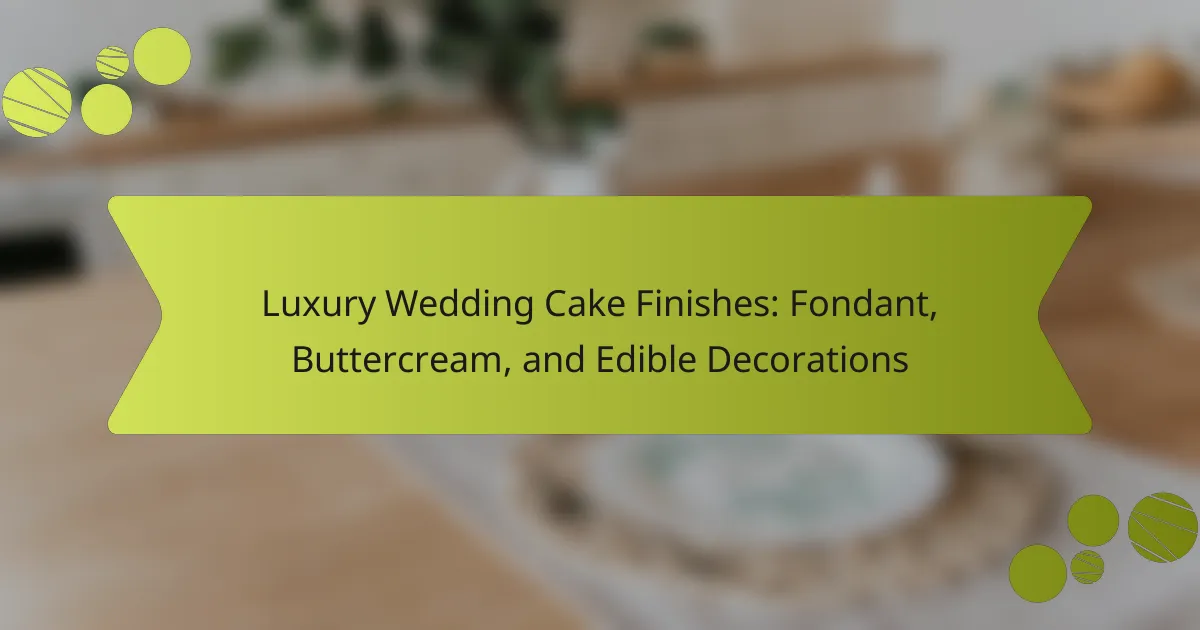Luxury wedding cake finishes encompass high-end decorative techniques that enhance the visual and sensory appeal of wedding cakes. Key finishes include fondant, known for its smooth and elegant surface, and buttercream, celebrated for its rich flavor and versatility. Edible decorations, such as intricate sugar flowers and gold leaf, add a personalized touch, contributing to the overall design and experience of the cake. The use of high-quality ingredients and skilled craftsmanship is essential to achieve these luxurious finishes, making them significant in the context of wedding celebrations.
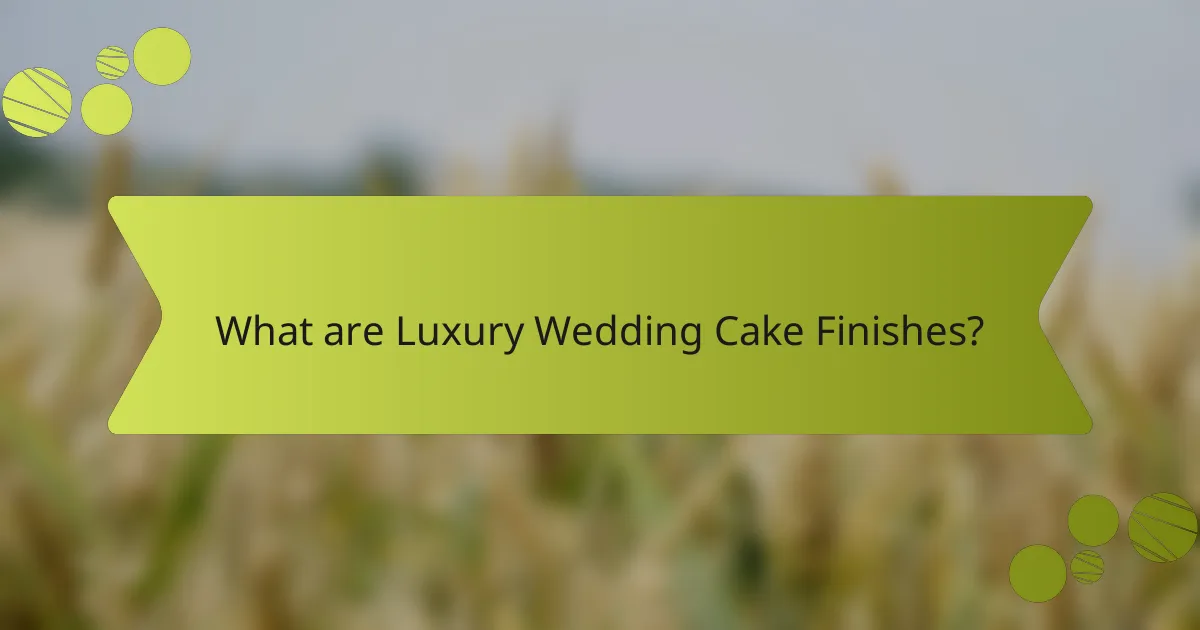
What are Luxury Wedding Cake Finishes?
Luxury wedding cake finishes are high-end decorative techniques used to enhance the appearance of wedding cakes. Common finishes include fondant, which provides a smooth, elegant surface. Buttercream is another popular choice, known for its rich texture and versatility. Edible decorations, such as gold leaf or intricate sugar flowers, add a personalized touch. These finishes not only elevate the cake’s aesthetic but also contribute to its overall flavor and experience. High-quality ingredients and skilled craftsmanship are essential for achieving these luxurious finishes.
How do Fondant, Buttercream, and Edible Decorations differ?
Fondant, buttercream, and edible decorations are distinct components used in cake design. Fondant is a smooth, pliable icing made from sugar, water, and gelatin. It provides a sleek finish and can be molded into shapes. Buttercream, on the other hand, is a creamy frosting made from butter and sugar. It is spreadable and can be piped into various designs. Edible decorations include items like sugar flowers, sprinkles, or edible glitter. These add visual appeal and enhance the cake’s theme. Each component serves a unique purpose in cake decoration, catering to different aesthetic and flavor preferences.
What are the key characteristics of Fondant?
Fondant is a smooth, pliable icing used for cake decoration. It is primarily made from sugar, water, and gelatin. This icing provides a sleek, polished finish on cakes. Fondant can be rolled out and draped over cakes easily. It holds its shape well and can be molded into intricate designs. The texture of fondant is soft yet firm, allowing for detailed decorations. Additionally, fondant can be flavored to enhance the cake’s taste. It is popular for wedding cakes due to its elegant appearance.
What are the key characteristics of Buttercream?
Buttercream is a sweet, creamy frosting made primarily from butter and sugar. It has a smooth, spreadable texture that allows for easy application on cakes. The flavor is rich and buttery, making it a popular choice for various desserts. Buttercream can be easily flavored or colored, enhancing its versatility. It can be piped into decorative shapes and designs due to its firm consistency when chilled. Additionally, buttercream can be made in different styles, such as American, Swiss, or Italian, each with unique preparation methods. Its widespread use in luxury wedding cakes is due to both its taste and aesthetic appeal.
What types of Edible Decorations are commonly used?
Common types of edible decorations include fondant, edible flowers, and chocolate decorations. Fondant is a smooth icing used for covering cakes and creating intricate designs. Edible flowers, such as roses or violets, add natural beauty and color. Chocolate decorations can be molded into various shapes and are often used for elegance. Other popular options are sugar paste, edible glitter, and fruit. Sugar paste allows for detailed designs and figures. Edible glitter provides a sparkling effect, enhancing visual appeal. Fruit adds freshness and a pop of color to the cake. These decorations are widely used in luxury wedding cakes for aesthetic enhancement.
Why are Luxury Wedding Cake Finishes important for weddings?
Luxury wedding cake finishes are important for weddings because they enhance the visual appeal of the cake. A beautifully finished cake serves as a centerpiece at the reception. It reflects the couple’s style and theme, contributing to the overall aesthetic of the event. Luxury finishes, such as fondant and intricate edible decorations, create a polished and elegant look. This attention to detail can elevate the entire wedding experience for guests. Furthermore, high-quality finishes often indicate superior ingredients and craftsmanship. Cakes with luxury finishes are typically more memorable and can leave a lasting impression.
How do these finishes enhance the overall wedding theme?
Luxury wedding cake finishes, including fondant, buttercream, and edible decorations, significantly enhance the overall wedding theme. Fondant provides a sleek, polished appearance that can be customized to match color schemes and designs. This versatility allows for intricate detailing, such as floral patterns or monograms, that align with the wedding’s aesthetic. Buttercream offers a more textured and rustic look, which can complement a vintage or garden-themed wedding. The creamy finish can also be easily colored and flavored, adding to the cake’s visual and taste appeal. Edible decorations, such as sugar flowers or gold leaf, can add unique touches that reflect the couple’s personality. These finishes create a cohesive visual narrative that ties the cake to the overall wedding decor, making it a focal point of the celebration.
What role do finishes play in cake presentation?
Finishes are crucial in cake presentation as they enhance visual appeal and texture. A well-executed finish can elevate the overall look of a cake. For instance, fondant provides a smooth, polished surface. This smoothness allows for intricate designs and decorations. Buttercream offers a more rustic, textured finish. This texture can create a homemade feel that appeals to many. Edible decorations, such as flowers or gold leaf, add unique elements to the cake. These elements make the cake stand out at events. Overall, finishes contribute significantly to the cake’s aesthetic and perceived quality.
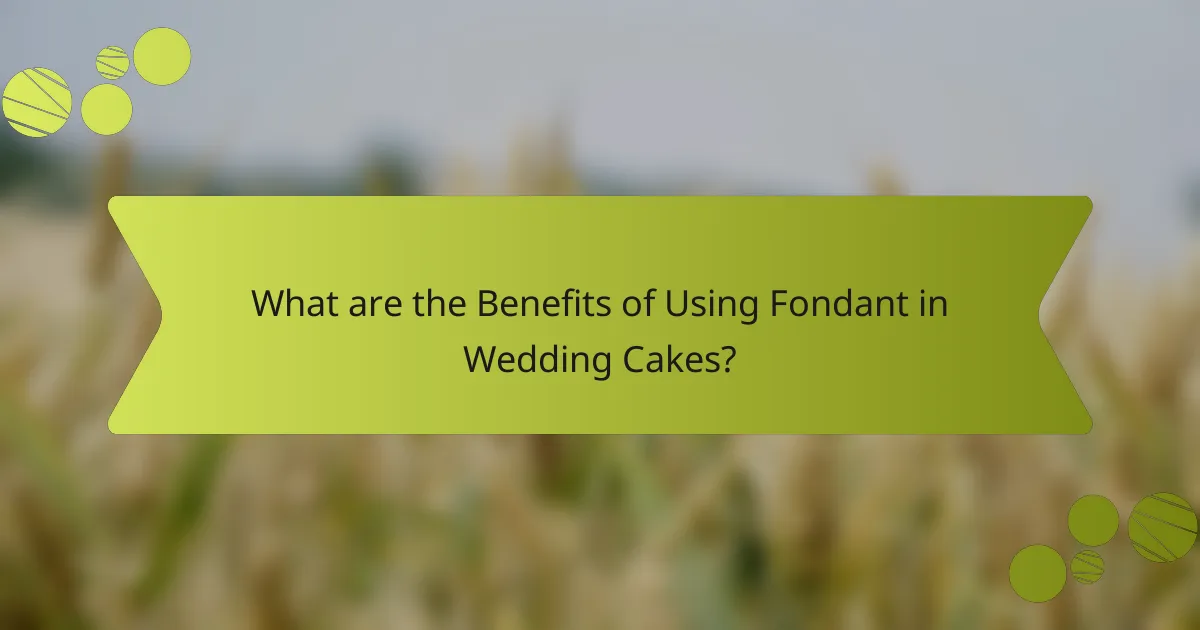
What are the Benefits of Using Fondant in Wedding Cakes?
Fondant provides a smooth and polished finish for wedding cakes. This icing allows for intricate designs and decorations. It can be rolled out to create a uniform layer. Fondant also holds its shape well, making it ideal for sculpted cakes. Additionally, it can be colored easily, allowing for customization. The texture of fondant can enhance the overall aesthetic appeal. It also helps to seal in moisture, keeping the cake fresh. These benefits make fondant a popular choice for luxury wedding cakes.
How does Fondant affect the cake’s texture and flavor?
Fondant significantly affects a cake’s texture and flavor. It creates a smooth, polished surface that enhances visual appeal. Fondant is chewy and adds a unique mouthfeel. The sweetness of fondant can overshadow the cake’s flavor. It often requires a complementary filling to balance taste. Fondant can also seal moisture, keeping the cake fresher longer. This moisture retention helps maintain a desirable texture over time. Additionally, different flavors of fondant can be used to enhance the overall taste experience.
What are the advantages of a smooth finish with Fondant?
A smooth finish with fondant provides a polished and professional appearance for cakes. This finish enhances the visual appeal, making cakes look more elegant and refined. A smooth surface allows for intricate designs and decorations to be applied seamlessly. Fondant’s pliability enables it to cover uneven surfaces, resulting in a flawless look. Additionally, it acts as a protective layer, keeping the cake moist and fresh. The versatility of fondant allows for a variety of colors and textures, adding to the cake’s aesthetic. A smooth fondant finish is often preferred for luxury wedding cakes, as it meets high standards of presentation.
How can Fondant be customized for different designs?
Fondant can be customized for different designs through various techniques. These techniques include coloring, shaping, and texturing. Fondant can be dyed using food coloring to achieve any desired hue. It can be rolled out and cut into shapes for decorative elements. Textures can be added using tools like embossers or stamps. Fondant can also be molded into figures or flowers for intricate designs. Additionally, it can be painted with edible paints for more detail. Each method allows for unique personalization of cakes. Customization enhances the visual appeal of luxury wedding cakes.
What are the common challenges with Fondant?
Fondant presents several common challenges for bakers. One major issue is its tendency to crack when rolled too thin. This occurs due to insufficient moisture content in the fondant. Another challenge is achieving a smooth finish on cakes. Uneven surfaces can lead to noticeable imperfections. Additionally, fondant can be difficult to work with in humid conditions. High humidity causes the fondant to become sticky and hard to manipulate. Temperature fluctuations also affect its consistency. If fondant is too warm, it can lose shape; if too cold, it can become brittle. Proper storage is essential to maintain its quality. Overall, these challenges require skill and experience to overcome.
How can one prevent Fondant from cracking?
To prevent fondant from cracking, ensure proper moisture levels in the fondant. Knead the fondant thoroughly to make it pliable. Use a thin layer of shortening on your hands and work surface to prevent sticking. Roll the fondant to an even thickness of about 1/8 inch. Avoid exposing fondant to dry air, which can cause it to dry out and crack. If fondant starts to dry, lightly mist it with water to regain moisture. Proper temperature control is essential; keep the cake in a cool, dry place. These methods help maintain the flexibility and smoothness of the fondant, reducing the risk of cracking.
What tips are there for applying Fondant smoothly?
To apply fondant smoothly, start with a well-prepared cake surface. Ensure the cake is chilled and covered with a layer of buttercream or ganache. Roll the fondant to an even thickness of about 1/8 inch. Use cornstarch or powdered sugar to prevent sticking while rolling. Drape the fondant over the cake gently, allowing it to settle into place. Smooth the fondant with a fondant smoother, starting from the top and working downwards. Trim excess fondant at the base of the cake. Finally, allow the fondant to rest for a few minutes to set before adding decorations. These steps ensure a professional finish on your cake.
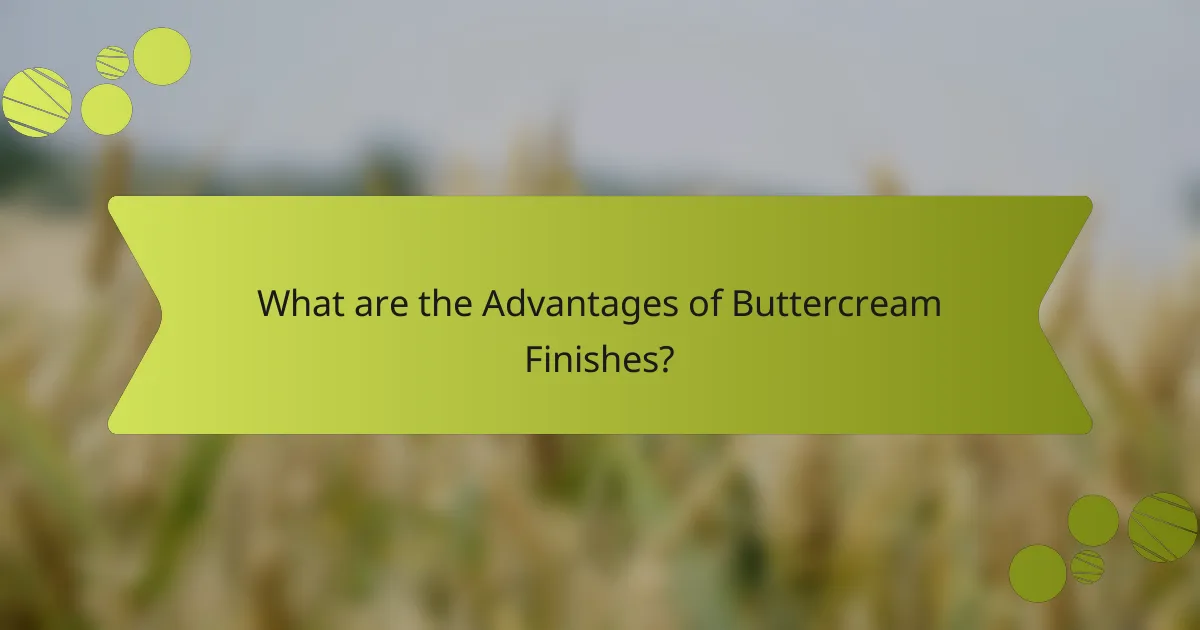
What are the Advantages of Buttercream Finishes?
Buttercream finishes offer several advantages for luxury wedding cakes. They provide a rich, creamy flavor that enhances the overall taste. Buttercream is versatile and can be easily colored or flavored to match wedding themes. It allows for smooth application and can create a variety of textures and designs. Additionally, buttercream is easier to work with than fondant, making it a preferred choice for intricate decorations. Unlike fondant, buttercream is more forgiving during temperature changes, maintaining its shape and appearance. It also tends to be more cost-effective compared to fondant finishes. Overall, buttercream finishes combine flavor, versatility, and ease of use, making them a popular choice for wedding cakes.
How does Buttercream contribute to flavor variety?
Buttercream contributes to flavor variety by allowing the incorporation of various flavorings and ingredients. It serves as a versatile base that can be easily customized. Common flavor variations include vanilla, chocolate, and fruit purees. Additionally, extracts like almond or peppermint can enhance the buttercream’s taste profile. The texture of buttercream also supports the addition of spices or liqueurs. This adaptability makes it suitable for different cake themes and occasions. Furthermore, the sweetness of buttercream can balance out rich or tart cake flavors. Overall, buttercream’s flexibility in flavoring options enhances the overall cake experience.
What types of Buttercream are popular for wedding cakes?
The popular types of buttercream for wedding cakes include American buttercream, Swiss meringue buttercream, and Italian meringue buttercream. American buttercream is known for its sweetness and ease of preparation. It consists mainly of butter and powdered sugar. Swiss meringue buttercream is smoother and silkier, made by heating egg whites and sugar before adding butter. Italian meringue buttercream is similar but uses hot sugar syrup, resulting in a stable and glossy finish. These buttercream types are favored for their flavor, texture, and versatility in decoration.
How does Buttercream handle temperature variations?
Buttercream is sensitive to temperature variations. At warmer temperatures, buttercream can become too soft and lose its structure. This can lead to melting or sagging, especially when used for decorative purposes. Conversely, at cooler temperatures, buttercream can harden and become difficult to spread or pipe. The ideal temperature for buttercream is around 70°F (21°C). At this temperature, it maintains a smooth, spreadable consistency. To manage temperature fluctuations, bakers often refrigerate buttercream to firm it up or allow it to sit at room temperature to soften before use.
What are the potential drawbacks of using Buttercream?
Buttercream can have several potential drawbacks. It is highly susceptible to temperature changes. Warm conditions can cause it to melt or lose its shape. This makes it less stable for outdoor events. Additionally, buttercream can be overly sweet for some tastes. This sweetness may overpower the flavor of the cake itself. Buttercream also requires refrigeration if not consumed quickly. This can complicate serving logistics at events. Lastly, intricate designs may be challenging to achieve with buttercream compared to fondant. These factors can influence the choice of frosting for luxury wedding cakes.
How can Buttercream designs be preserved in warm weather?
Buttercream designs can be preserved in warm weather by keeping the cake refrigerated until serving. Refrigeration slows down the melting process of the buttercream. Use a sturdy cake base to support the weight of the decorations. Additionally, avoid direct sunlight and heat sources that can cause the buttercream to soften. Using a high-ratio shortening in the buttercream can improve its stability in warm conditions. According to the American Institute of Baking, buttercream made with shortening can withstand higher temperatures than traditional butter-based recipes.
What are effective techniques for achieving Buttercream smoothness?
To achieve buttercream smoothness, use a few effective techniques. First, ensure the buttercream is at room temperature. This helps it spread easily. Second, use a bench scraper or offset spatula to smooth the surface. Hold the scraper at a 45-degree angle for best results. Third, apply a thin crumb coat before the final layer. This traps crumbs and provides a smoother base. Fourth, heat your spatula with warm water before smoothing. This melts the buttercream slightly for a polished finish. Lastly, chill the cake briefly after applying the final coat. This firms up the buttercream and makes it easier to smooth. These methods are commonly used by bakers to achieve a professional finish.
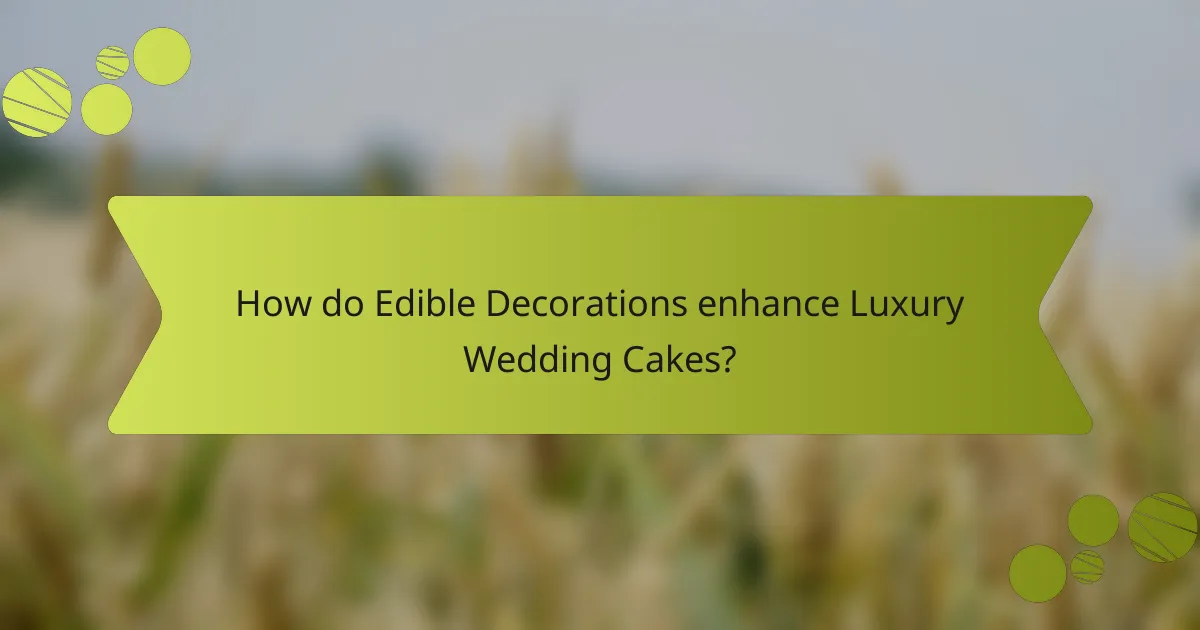
How do Edible Decorations enhance Luxury Wedding Cakes?
Edible decorations enhance luxury wedding cakes by adding visual appeal and personalization. They can be crafted from materials such as sugar, chocolate, or fondant. These decorations can include intricate sugar flowers, edible gold leaf, and personalized cake toppers. They contribute to the overall aesthetic by complementing the cake’s design theme. Edible decorations also elevate the sensory experience through unique flavors and textures. Many luxury cakes feature custom designs that reflect the couple’s style or wedding theme. This customization creates a memorable experience for guests. According to a survey by The Knot, 90% of couples consider cake design important for their wedding. Thus, edible decorations play a crucial role in making luxury wedding cakes visually stunning and meaningful.
What types of Edible Decorations can be used?
Edible decorations can include a variety of items such as edible flowers, sprinkles, and chocolate decorations. Edible flowers like violets and pansies add color and elegance to cakes. Sprinkles come in various shapes and sizes, enhancing visual appeal. Chocolate decorations, including curls and molded shapes, provide richness and texture. Additionally, fondant can be shaped into intricate designs for a polished finish. Sugar art can create stunning, detailed figures that impress guests. Finally, fruit can be used for a fresh, natural look on cakes. Each type of decoration contributes to the overall aesthetic and flavor profile of the cake.
How do Sugar Flowers differ from other edible decorations?
Sugar flowers are distinct from other edible decorations due to their intricate craftsmanship and realism. Unlike simpler decorations such as sprinkles or chocolate shavings, sugar flowers are often handmade, requiring specialized techniques. They can mimic the appearance of real flowers with detailed petals and lifelike colors. Sugar flowers are typically crafted from gum paste or fondant, which allows for greater flexibility in shaping. This material can hold intricate details, making them suitable for high-end cake designs. Additionally, sugar flowers can be preserved for longer periods, maintaining their appearance without wilting. Their use elevates the aesthetic of luxury wedding cakes, providing a touch of elegance that basic decorations cannot achieve.
What are the benefits of using Edible Glitter and Paint?
Edible glitter and paint enhance the visual appeal of baked goods. They add a sparkling effect that attracts attention. This can elevate the overall presentation of luxury wedding cakes. Edible glitter comes in various colors and sizes, allowing for customization. Edible paint provides the ability to create intricate designs. Both options are safe for consumption, making them ideal for food decoration. They can be used on fondant, buttercream, and other surfaces. The use of these decorations can make a cake memorable and unique.
How can Edible Decorations be incorporated into cake designs?
Edible decorations can be incorporated into cake designs by using various techniques and materials. These decorations include items like edible flowers, sugar art, and chocolate embellishments. They can enhance the visual appeal and theme of the cake. For example, edible flowers can be placed on top or around the sides for a natural look. Sugar art can be molded into intricate shapes and used as toppers. Chocolate decorations can be crafted into curls or shards for added texture. Additionally, edible glitter can be sprinkled for a touch of sparkle. These elements not only beautify the cake but also contribute to its flavor profile. Incorporating edible decorations allows for creativity and personalization in cake design.
What are the best practices for placing Edible Decorations?
The best practices for placing edible decorations include ensuring the surface is clean and dry. This prevents sliding and maintains the decoration’s integrity. Use a small amount of edible glue or royal icing to secure decorations. This method enhances stability and prevents them from falling off. Additionally, consider the weight of the decorations. Heavier items should be placed lower on the cake to maintain balance. Arrange decorations in a visually appealing manner, following design principles like symmetry or the rule of thirds. Finally, place decorations just before serving to maintain freshness and prevent wilting or damage. These practices ensure that edible decorations enhance the cake’s aesthetic and remain intact.
How can Edible Decorations complement other finishes?
Edible decorations enhance other finishes by adding visual appeal and texture. They provide contrast to smooth surfaces like fondant and buttercream. For instance, sugar flowers or edible glitter can create a striking effect against a matte finish. Edible decorations also allow for personalization, making cakes more unique. They can be tailored to match wedding themes or color schemes. This customization adds emotional value to the cake. Moreover, edible decorations can enhance flavor profiles when incorporated into the cake design. Their versatility makes them an essential element in luxury wedding cake presentations.
What are the best tips for choosing the right finish for a wedding cake?
Choose a finish based on the desired aesthetic and flavor. Fondant provides a smooth, polished look and is ideal for intricate designs. Buttercream offers a softer texture and can be flavored in various ways. Consider the wedding theme; elegant themes may suit fondant, while rustic themes may favor buttercream. Test the taste of finishes before deciding. Pair the finish with the cake’s flavor for a cohesive experience. Assess the climate; fondant can hold up better in heat compared to buttercream. Lastly, consult with a professional baker for expert recommendations tailored to your specific needs.
Luxury wedding cake finishes encompass high-end decorative techniques, primarily focusing on fondant, buttercream, and edible decorations. Fondant offers a smooth, elegant surface ideal for intricate designs, while buttercream provides a rich, creamy flavor and versatility in decoration. Edible decorations, including sugar flowers and edible glitter, enhance the visual appeal and personalization of the cake. The article outlines the characteristics, advantages, and challenges of each finish, emphasizing their importance in cake presentation and how they contribute to the overall wedding theme and guest experience.
